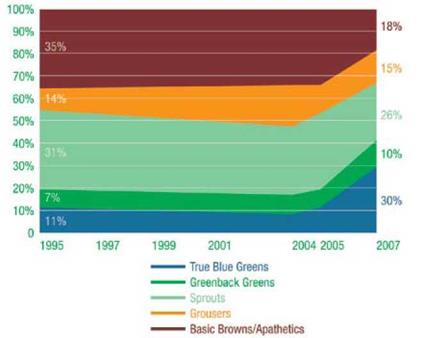Another segmentation, Green Gauge, comes from GfK Roper Consulting, and it describes five groups, based on their buying behavior around environmental concerns (see Figure 18.1). This is probably the longest-running survey of “green” perceptions, and it has shown
|
FIGURE 18.1. /И http://flickr. com/photos/rosenfeldmedia/3273317718 The Green Gauge market segments. |
a lot of change just in the past three years (following very little change in the proceeding decade).
2007
30% True Blue Greens (most committed)
10% Greenback Greens (interested but not always willing to spend more)
26% Sprouts (undecided about environmental issues)
15% Grousers (view environmental issues as too big or complicated to do anything about) 18% Apathetics (not interested in environmental issues)
Where the most committed consumers (dubbed True Blue Greens) consistently accounted for only around 10 percent of the population in the U. S. for many years, beginning in 2004, it began to increase and jumped significantly to 30 percent just last year (2007). In total, the top three segments, representing consumers who respond to environmental issues to some extent has grown from 55 percent to 65 percent. These figures differ greatly from the results of other studies, however (see below).
2005
11% True Blue Greens (most committed)
8% Greenback Greens (interested but not always willing to spend more)
33% Sprouts (undecided about environmental issues)
14% Grousers (view environmental issues as too big or complicated to do anything about) 33% Apathetics (not interested in environmental issues)
2004
9% True Blue Greens (most committed)
6% Greenback Greens (interested but not always willing to spend more)
31% Sprouts (undecided about environmental
issues)
19% Grousers (view environmental issues as too big or complicated to do anything about) 33% Basic Browns (not interested in environmental issues)
1995
11% True Blue Greens (most committed)
7% Greenback Greens (interested but not always willing to spend more)
31% Sprouts (undecided about environmental
issues)
14% Grousers (view environmental issues as too big or complicated to do anything about) 35% Basic Browns (not interested in environmental issues)
In both of these segmentations, environmental issues were the focus. While social issues may have been included as part of this research, these segments didn’t deeply research a broad range of social issues other than those dealing with the environment.




